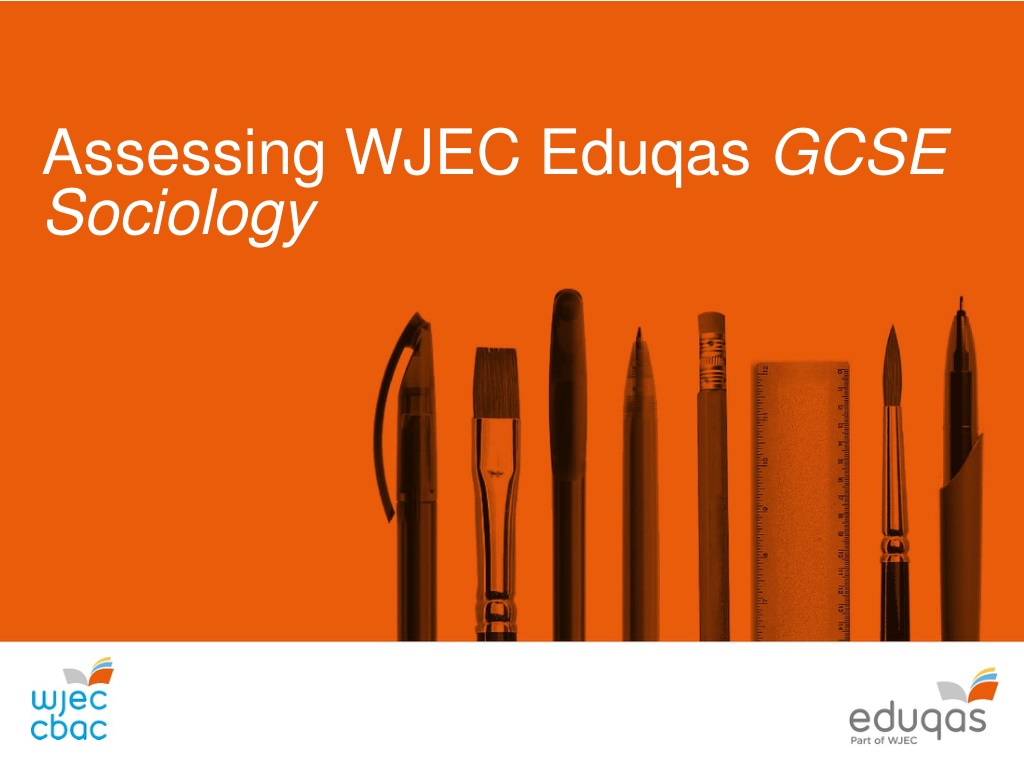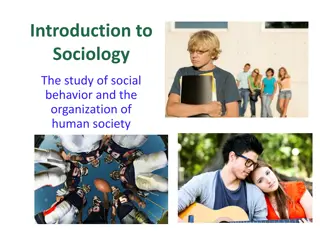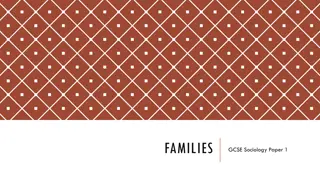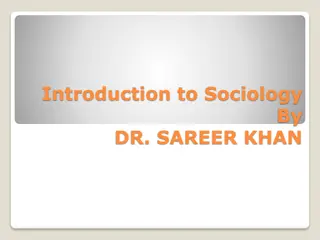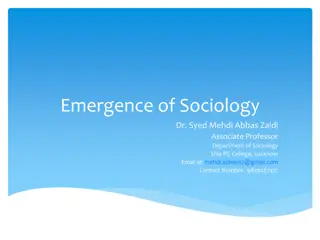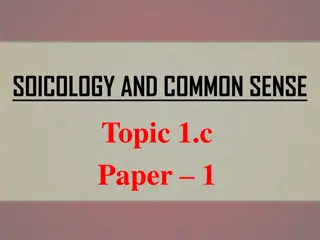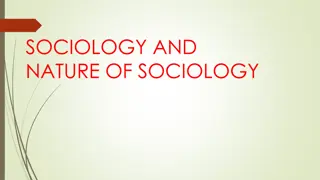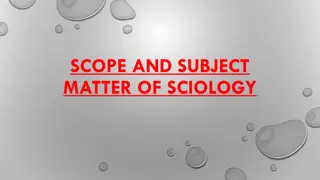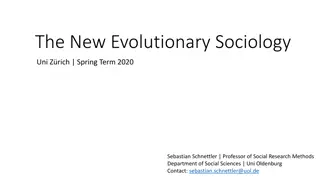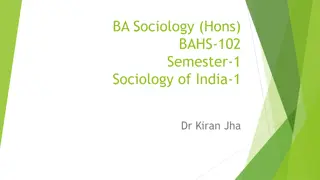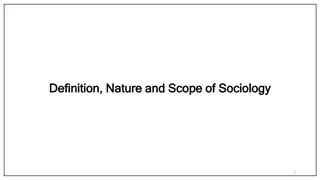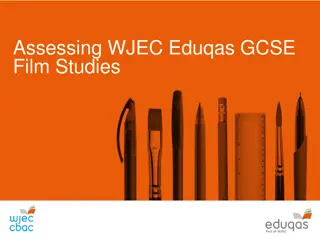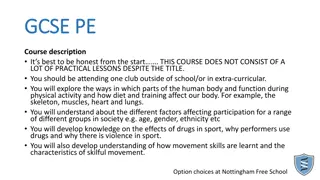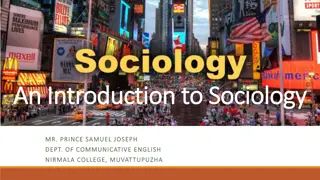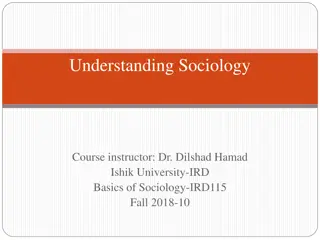Understanding Assessment Criteria in GCSE Sociology
Assessing evidence in WJEC Eduqas GCSE Sociology involves evaluating candidates based on AO1, AO2, and AO3 skills. The assessment objectives emphasize knowledge, application, analysis, and evaluation of sociological theories, concepts, evidence, and methods. Understanding mark bands, successful response characteristics, and question requirements are crucial for achieving higher marks in GCSE Sociology Component 1.
Download Presentation

Please find below an Image/Link to download the presentation.
The content on the website is provided AS IS for your information and personal use only. It may not be sold, licensed, or shared on other websites without obtaining consent from the author. Download presentation by click this link. If you encounter any issues during the download, it is possible that the publisher has removed the file from their server.
E N D
Presentation Transcript
Assessing WJEC Eduqas GCSE Sociology
Assessing evidence Please read the qualification overview PowerPoint first. This PowerPoint focuses on applying the marking criteria in GCSE Sociology Component 1 You will also need access to the following documents: relevant marking schemes exemplar material GCSE specification
Assessing evidence Assessment Objectives Candidates are assessed on AO1, AO2 and AO3 skills AO1 Demonstrate knowledge and understanding of sociological theories, concepts, evidence and methods. AO2 Apply knowledge and understanding of sociological theories, concepts, evidence and methods. AO3 Analyse and evaluate sociological theories, concepts, evidence and methods in order to construct arguments, make judgements and draw conclusions.
Assessing evidence Assessment objectives Not all questions assess all skills. The lower tariff questions (marks 1-5) assess AO1 skills, AO2 skills or both. The higher tariff questions also assess AO3 skills Questions requiring AO3 require a discussion and will ask candidates to discuss a view or ask if they agree with the view in the question. To score AO3 marks, candidates must discuss a view, compare with other views/reasons, make a judgement and reach a conclusion specific to the question rather than just describing or explaining a view/reason.
Assessing evidence Mark Bands In the higher tariff questions, mark bands are used to allocate candidates responses These bands give an idea of what is expected in the responses. There are usually 3 or 4 mark bands. Each band contains descriptors that describe the features of the response. These key descriptors remain the same. Examiners use these to decide which band the candidate s answer fits into. For example, band 4 AO1 will ask for detailed, relevant knowledge and understanding of a range of factors /reasons
Assessing evidence Some mark bands contain a range of marks within each band allowing for examiners to judge where the response fits in that band. If the response fits most of the characteristics described in the band, then the response should be placed at the top end of the band. If it misses some of the characteristics, it should be placed towards or at the bottom of the band.
Assessing evidence Characteristics of a successful response A successful response will address the command words. Command words such as describe, explain, identify require AO1 and/or AO2 skills only. Command words such as discuss or a question asking the candidate if they agree with a statement require AO3 skills in addition. Appropriate and sustained sociological language and concepts are one of the features of the top band. A response can fulfil the characteristics of the top band without names of sociologists but when used appropriately sociologists can enhance an answer and provide evidence to support points. Sociological theory, if used appropriately, will be rewarded.
Assessing evidence AO1 skills Top band answers for AO1 require detailed, relevant knowledge and understanding of a range of factors/reasons and sustained, sociological language. The following example clearly fulfils these requirements. Knowledge and understanding are detailed and relevant and it is packed with concepts and sociological terms. It easily achieves the full five marks for AO1 Assessment Set 4, question 1b: Outline the Functionalist view of the role of education. Functionalists see education as a good thing because it teaches the required norms and values of society. It does this by both the formal and hidden curriculum. Functionalist believe education prepares you for work and believe in meritocracy which means the best jobs go to the hardest workers which acts as motivation for pupils to do well in school so they can have good jobs. Functionalists see education as a building block of society.
Assessing evidence AO2 skills To gain AO2 marks, candidates must apply their answer to the question. In the following answer to the question asking why women are having fewer children in contemporary Britain, the reason (cost of having children) is then applied and explained in the context of the question. Another reason women are having fewer children is that the cost of having children has increased (AO1) (this is then developed). This leads to women having fewer children to be able to afford a better standard of living. (linked back to question: AO2)
Assessing evidence The following phrases, if used correctly, may flag up AO2 skills. Phrases such as: This shows that The relevance of this is Therefore This means that The implication of this is This can be seen in This can be applied to
Assessing evidence Questions which require all 3 skills For example Set 3 question 4d: Some sociologists suggest that nuclear families, with two parents of opposite sexes, are good for society. Do you agree with this view? (15 marks) For this question, there are 4 AO1 marks; 3 AO2 marks and 8 AO3 marks. The mark scheme states that in order to to be placed in the top band for AO1, there must beknowledge and understanding of three different views/theories in the answer: the view expressed in the question and two different views opposing this view. There must be knowledge and understanding of theories, evidence and concepts and sustained sociological language. There should be reference to sociologists and their views/research. Candidates must not just state/describe the different views, they must evaluate and discuss them. There should be discussion throughout the essay, not left to the end. There is a definite view expressed in the question and candidates should come to a conclusion on that view.
Assessing evidence These words/phrases, if used correctly, usually flag up AO3 skills: on the other hand however alternatively a strength of this is a weakness of this is although this lacks support whereas the problem with this is
Assessing evidence Conclusion In order to get into the top band for AO3, the discussion must come to a conclusion. These words and phrases flag up a conclusion: the balance of the argument suggests having looked at different views to sum up in conclusion The conclusion does not necessarily have to come out in favour of one view. It could be that In some ways the nuclear family can be good for society but in other ways .
Assessing evidence Assessment set 3, question 4(d) Some sociologists suggest that nuclear families, with two parents of opposite sexes, are good for society. Do you agree with this view? (15 marks) Some sociologists argue that the nuclear family is the best family type and the most beneficial for society. However other perspectives disagree and argue it has a negative effect on society. Marker s comment: A brief introduction which shows awareness that there are different views on the statement. Functionalists argue that the nuclear family consisting of two families of opposite sexes is the best and most beneficial of family types. As argued by Murdock and Parsons the nuclear family carries out many functions. Murdock argues the nuclear family carries out four main functions: reproduction, primary socialisation, stabilisation of adult personalities and economic stability. This means that children are taught the right norms and values to fit into society. Marker s comment. At this level, detailed and relevant knowledge and understanding of the view in question. Points developed. However, this could be improved by some evaluation of the view. Additionally, functionalists would argue that having one parent of each sex is beneficial as it teaches the correct behaviour for each gender and gives children role models.
Assessing evidence However Marxists would disagree with Functionalists and would instead argue that the nuclear family is negative instead of positive. Marker s comment: Knowledge and understanding of an alternative view to the one in the question. Awareness of how this view differs from the main view. Zaretsky argues that the family props up capitalism and also works as a unit of capitalism where people buy things such as holidays and cars which benefits capitalism. Therefore Marxists would disagree with Functionalists and instead argue that the nuclear family is exploited by the Bourgeoisie and used for the benefit of Capitalism. Furthermore, Feminists would also disagree with Functionalists that the nuclear family is positive and would instead argue that the nuclear family is used to oppress women. This is because women are forced into gender stereotyped roles and expected to be housewives and to carry out their expressive role, This leads to women not having a career and being used for the benefit of men. Marker s comment: Third view explained and differentiated from the view in the question. To conclude, Functionalists argue that the nuclear family is the most beneficial family type whereas Marxists and Feminists argue that it is used and exploited for the benefit of others. Marker s comment: There is a conclusion. Could have been improved by some judgement.
Assessing evidence Assessment This essay reaches the top band for each assessment objective. AO1: 4 marks. There is detailed, relevant knowledge and understanding of view in question and two alternative views. There is sustained use of sociological language, concepts and theories. AO2: 3 marks. Knowledge and understanding is applied to question and explained in the context of the question AO3 7 marks There is developed analysis.There is discussion of the views as opposed to mere description or explanation. There is a sustained line of reasoning. Judgements are made and there is a conclusion linked to the specifics of the question. To get to the top of the band, there could have been specific evaluation of the theories.
Assessing evidence Characteristics of a less successful response. Knowledge and understanding will be basic. There will be little use of sociological language and concepts Explanations will be undeveloped. There will be little application to the question. For questions requiring AO3 Factors/reasons will be described and there will be little evaluation. Alternative views may be described without reference to the differences or comparisons. There will be no conclusion linked to the specifics of the question.
Assessing evidence Assessment Set 4, question 2(c): Discuss the strengths and weaknesses of observation as a method of research. One strength of observation is that they are high in reliability. Marker s comment: No indication the candidate understands the term reliability and no explanation or development. One disadvantage is that it may cause the Hawthorne effect where the teenagers may alter their behaviour making the data nor a true reflection of the general opinion. Marker s comment: Some credit for point made. Candidate refers to teenagers but question does not require contextualisation. Another disadvantage is receiving consent, especially for children and teenagers is difficult. Also it is time consuming so not effective. One advantage is that teenagers cannot lie and there is no risk of low response rate. Marker s response: Again, no explanation or development.
Assessing evidence This response is placed in the following bands: AOI Band 2: 2 marks There is partial knowledge and understanding of strengths and weaknesses though lacking in detail and with inaccuracies. AO2 Band 2: 2 marks. There is some development in application to question and but with limited detail. AO3 Band 1: 1 mark. There is limited analysis of strengths and weaknesses. Evaluation is limited, strengths and weaknesses are described only. No judgement or conclusion in relation to the specifics of the question.
Assessing evidence Potential problem areas Always mark positively and reward what candidates have written as opposed to deducting marks for errors. In the essay questions carrying 15 marks, eight of these are for AO3 skills, analysis and evaluation. Remember to reward for analysis. Candidates who just list different views will not score highly for evaluation but may still make the lower bands if they show some awareness that the views are different from each other. In questions asking for 2 ways in which families/peer groups etc socialise children, candidates focus on what is taught rather than how it is taught. Credit reference to how they teach not what. Questions 2(b) in Assessment sets 2, and 6 on sociological research methods require contextualisation to gain full marks.
Any Questions? If you have any questions, contact our specialist subject officers and administrative support team for your subject with any queries. GCSESociology@eduqas.co.uk
